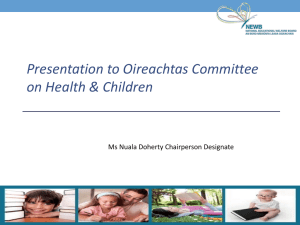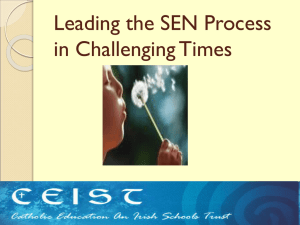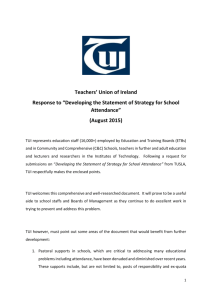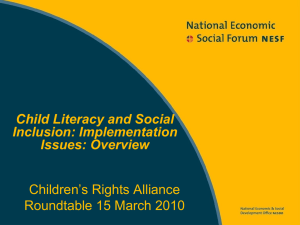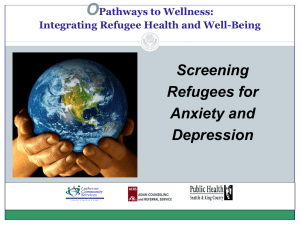HOME SCHOOL COMMUNITY LIAISON (HSCL)
advertisement
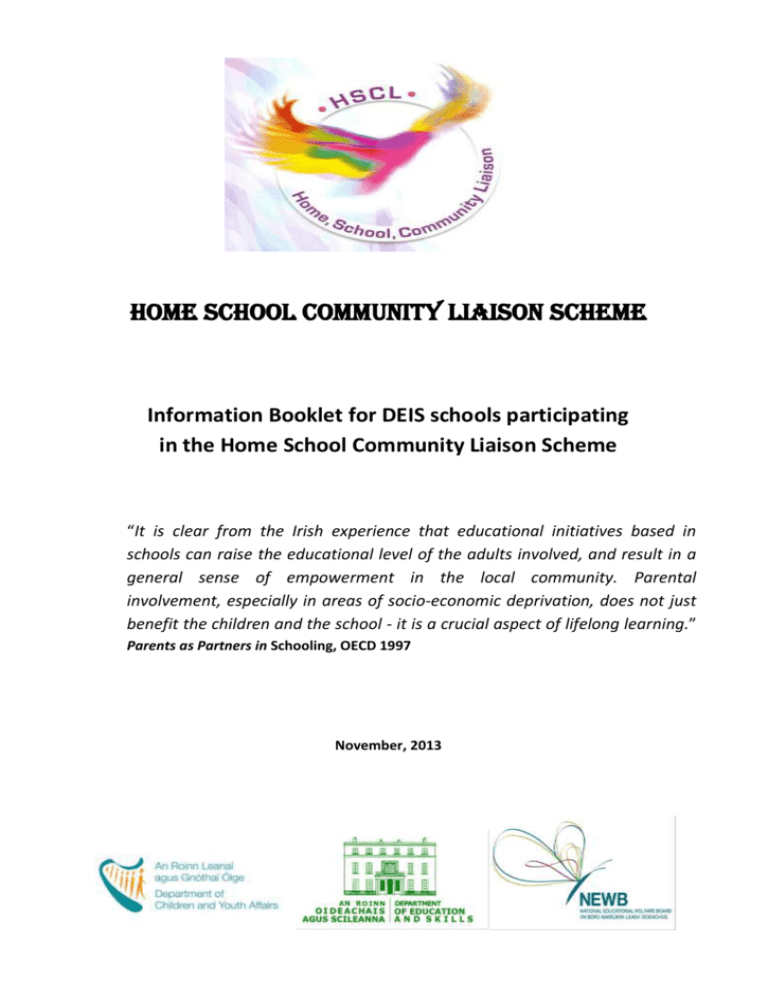
HOME SCHOOL COMMUNITY LIAISON Scheme Information Booklet for DEIS schools participating in the Home School Community Liaison Scheme “It is clear from the Irish experience that educational initiatives based in schools can raise the educational level of the adults involved, and result in a general sense of empowerment in the local community. Parental involvement, especially in areas of socio-economic deprivation, does not just benefit the children and the school - it is a crucial aspect of lifelong learning.” Parents as Partners in Schooling, OECD 1997 November, 2013 Contents Topic Contents The HSCL Scheme – Historical Background DEIS and HSCL DEIS Planning Process and the HSCL Scheme HSCL – As Part of an Integrated Service within NEWB NEWB’s Integrated Services Practice Model Vision and Values of HSCL HSCL Scheme – Key Priorities Attributes of the HSCL Coordinator Job Description/Role of the HSCL Coordinator Assignment of HSCL Coordinators Appendix A: Contact Details Appendix B: HSCL Grants to schools – Guidelines on the use of the HSCL Grant Appendix C: Sample Planning and Reporting Templates for HSCL Coordinators Appendix D: Useful publications Page 1 2 3 4 5 6 7 9 10 11 12 13 14 16 20 This Information Booklet is available on the Department of Education and Skills website at www.education.ie and also the National Educational Welfare Board’s website at www.newb.ie 1 The HSCL Scheme – Historical Background “The underlying policy of the Home School Community Liaison (HSCL) Scheme is one that seeks to promote partnership between parents and teachers. The purpose of this partnership is to enhance pupils’ learning opportunities and to promote their retention in the education system. In addition, the HSCL Scheme places great emphasis on collaboration with the local community. The HSCL Scheme is the pioneer in involving the school in the life of the community and involving the community and its agencies in the life of the school.” The Home School Community Liaison Scheme in Ireland: From Vision to Best Practice written by the HSCL Coordinators, 2005-2006. The HSCL Scheme was initiated as a pilot project in 1990. It was designed as a result of a review carried out on the Disadvantaged Areas Scheme, a scheme introduced in 1984, which provided additional funding to primary schools in disadvantaged areas. The HSCL Scheme was initially a three year pilot scheme, which involved the appointment of thirty teachers as HSCL Coordinators, in fifty five selected primary schools included in the Disadvantaged Areas Scheme at the time. It was extended in 1991 to a further 13 post primary schools, that served the children from the original selected primary schools. The three year pilot phase of the HSCL Scheme ended in June 1993. All disadvantaged primary and post primary schools in the Disadvantaged Areas Scheme were offered a Home School Community Liaison service from September 1999. The HSCL Scheme was further extended in 2005 under DEIS (Delivering Equality of Opportunity in Schools), the Action Plan for educational inclusion. Evaluations carried out by the Educational Research Centre (ERC) on the HSCL Scheme include the following: “Review of the Home-School-Community Liaison Scheme - Report to the Department of Education and Science” by Peter Archer and Fionnuala Shortt, published by the Educational Research Centre, 2003 (available on www.erc.ie) “The Home-School-Community Liaison Scheme - Final evaluation report” published by the Educational Research Centre, 1994 (available on www.erc.ie) 2 DEIS and HSCL DEIS was launched in May 2005 and remains the Department of Education and Skills policy instrument to address educational disadvantage. It replaces all previous disadvantaged schemes, namely the Disadvantaged Areas Scheme, Breaking the Cycle and Giving Children an Even Break. All DEIS Urban Primary and DEIS Post Primary schools are currently included in the HSCL Scheme. Under the National Recovery Plan 2011 to 2014, Rural DEIS schools were withdrawn from the Rural Coordinator service under HSCL in September, 2011. The DEIS frame of reference is based on the definition of “educational disadvantage” in the Education Act (1998) as: “…the impediments to education arising from social or economic disadvantage which prevent students from deriving appropriate benefit from education in schools.” DEIS focuses on addressing and prioritising the educational needs of children and young people from disadvantaged communities, from pre-school through second-level education (3 to 18 years), through the School Support Programme, which includes a suite of interventions comprising in-school and out-of-school supports. These supports include enhanced teaching resources in schools with the highest levels of disadvantage; additional financial resources for all DEIS schools; access to literacy and numeracy supports; curricular supports; planning and professional development supports, transfer programmes from primary to post primary and access programmes to third level. In addition, the School Support Programme includes two major interventions, namely, the HSCL Scheme and the School Completion Programme (SCP). Among the key measures implemented under the DEIS Action Plan are: the streamlining of measures for addressing educational disadvantage, targeted measures to address problems of literacy and numeracy, measures to enhance student attendance, educational progression, retention and attainment. Central to the success of the DEIS Action Plan is an increased emphasis on planning at school and school cluster level, target-setting and measurement of progress and outcomes, to ensure that the increased investment is matched by an improvement in educational outcomes for the children and young people concerned. In addition, schools are expected to place a renewed emphasis on the involvement of parents and families in children’s education by incorporating the HSCL function into their three-year DEIS Action Plan. 3 Three reports arising from research in DEIS schools, undertaken separately and independently by the ERC and the Department’s Inspectorate in 20111, conclude that …“There is clear evidence that the DEIS programme is having a positive effect on tackling educational disadvantage”. The report on the first phase of the evaluation of DEIS found clear evidence that achievement in reading and mathematics in sample DEIS urban primary schools was higher in 2010 than in 2007. The difference was statistically significant and was found at all grade levels. Progress appeared most marked among pupils with lower levels of achievement and positive change in achievement was most evident in junior grades. In terms of the provision of activities for parents, the reports from both the ERC and the Department’s Inspectorate confirm that schools are extremely conscious of the importance of positive school-parental linkages. Both the ERC and the Department’s Inspectorate reports confirm that primary schools are maintaining and continuing to provide activities for parents, including activities that are related to their children’s learning. At post primary level, the Department’s Inspectorate evaluation findings point to positive engagement by schools, in implementing interventions to improve partnership with parents and the community. DEIS Planning Process and the HSCL Scheme “Schools that receive additional support and resources through participation in DEIS are expected to support the DEIS Action Plan through a systematic planning and monitoring process at individual school level and at school/cluster/community level. The involvement of students, parents, local communities and agencies operating at local level is considered an important dimension of the planning process. Schools are expected to develop Action Plans focussing on the following areas: attendance, retention, educational progression, literacy and numeracy, examination attainment (at post primary), parent and community partnership, partnership between schools and links with external agencies. Progress in the implementation of these Action Plans should be kept under review and adjusted in light of experience.”An Evaluation of Planning Processes in DEIS Primary Schools, Inspectorate, DES, 2011 1• A Report on the First Phase of the Evaluation of DEIS, Susan Weir and Peter Archer, ERC, 2011 www.erc.ie • An Evaluation of Planning Processes in DEIS Primary Schools, Department’s Inspectorate, DES, 2011 www.education.ie • An Evaluation of Planning Processes in DEIS Post Primary Schools, Department’s Inspectorate, DES, 2011 www.education.ie 4 The HSCL Coordinator plays a critical role in supporting the development, implementation, evaluation and review of the school’s DEIS Action Plan, particularly in the promotion of parental involvement. HSCL – As Part of an Integrated Service within NEWB Since mid-2009 the remit of the National Educational Welfare Board (NEWB) has expanded to include responsibility for the HSCL Scheme and SCP in addition to the Educational Welfare Service (EWS). A Memorandum of Agreement between the NEWB and the Department of Education and Skills outlines the NEWB’s obligation to develop: “…a single, strategic approach reflecting equally the nature of and strengths of each of the services, including the National Educational Welfare Service to address school attendance, participation and retention.” The NEWB was mandated to assume: “…responsibility for the management, development and direction of the Home School Community Liaison Programme, the School Completion Programme in line with Department policy. “ The Department of Education and Skills and NEWB agreed that: “The NEWB will put in place a process and structures for the development of the single strategic approach, for the governance, management and operation of the integrated service, including the use of the allocated human and financial resources to provide an integrated service to children, families and schools, aimed at eliminating poor attendance and early school leaving and maximising school retention and participation.” Essentially, the three service strands of NEWB are committed to “maximising student attendance, participation and retention.” The management arrangements provide for a single, focused strategic direction at local, regional and national levels, reflecting equally the nature and strength of each of the three services. It brings together personnel throughout the country, strengthening the functions of the individual services, while contributing significantly to the capacity of the NEWB to deliver on its statutory remit, thus bringing about improved outcomes for children, families and schools. In June 2011, certain functions under the Education (Welfare) Act 2000, including the NEWB and the integrated services under the remit of the Board, transferred from the Minister of Education and Skills to the Minister for Children and Youth Affairs. Given the particular remit of the NEWB, 5 through its integrated service strands, in relation to school attendance, participation and retention, it continues to work directly with the Department of Education and Skills, in order to support and consolidate the work of schools, in ensuring that children’s participation in the educational system is maximised. The Department of Education and Skills remains responsible for the allocation of HSCL Coordinators to schools. NEWB’s Integrated Services Practice Model The aim and rationale for the NEWB’s integrated services strategy is to provide more effective service delivery for children who have difficulties participating in school; foster and develop improved engagement with other agencies and services working with children and families; influence more effective policy making with an increased emphasis on planning, outcome measurement and the gathering of evidence on the impact of interventions. An integrated services practice model, incorporating the three service strands, (EWS, HSCL & SCP) is in an advanced stage of development. The practice model is designed to facilitate a standardisation of service delivery across the country; fully acknowledging and accommodating the particular functions and contributions of each strand, whilst also taking into consideration the need for flexibility between and across the strands, given the unique nature of difficulties presenting in individual children’s lives. This shared script for all strands across the NEWB, with key messages on roles, ways of working and outcomes, will mean that families receive a more consistent service, as well as helping staff to look beyond the immediate presenting need. Separate guidelines are in preparation for schools and staff, in respect of the NEWB’s integrated services practice model. At the time of issuing this Information Booklet, there is an imminent merger of the NEWB’s functions in to the new Child and Family Agency (CFA). 6 Vision and Values of HSCL HSCL is a full-time undertaking. HSCL Coordinators are released from all teaching duties and engage in full-time liaison work between the home, the school, and the community. Under no circumstances, can a HSCL Coordinator be timetabled for teaching duties in the school. The scheme operates in a spirit of partnership and collaboration with parents and teachers, while at the same time, being part of an ongoing and wider integrated services approach to children’s educational welfare. The scheme is unified and integrated at both primary and post primary levels. The thrust of the scheme is preventative, ensuring that interventions are put in place, which will impact positively on parents and children, in order to improve educational outcomes. The focus of the scheme is principally on the salient adults, whose attitudes and behaviours impinge on the attendance, participation and retention of children in education. This involves the identification of and response to needs, through a set of interventions, which are evidence- based. The scheme helps to develop and promote teacher and staff attitudes to partnership. It encourages a whole-school approach to improving attendance, participation and retention in education. The scheme is solution-focused, building on the strengths of parents and carers through empowerment and capacity-building. Visiting families in their home setting is a crucial element in establishing trust, assessing needs, and monitoring the effect of plans and interventions put in place to bring about improved outcomes for children. Partnership with other NEWB strands, support services and voluntary and statutory agencies is essential to increasing effectiveness, reducing duplication and providing an integrated delivery of service to marginalised children and their families. The HSCL Coordinator is required to link with and work with the key players in the local community, so that they can add value to what is done in the school, in relation to attendance, participation and retention. 7 The HSCL Coordinator is an agent of change, not only for individuals and families but also for schools and the wider educational system. In summary, the HSCL Scheme: Targets children at risk of not reaching their potential in the educational system because of family-based issues, which adversely affect pupil attainment and school retention. Focuses directly on the significant adults in children’s lives and seeks direct benefits for the children themselves. Works in an enabling way with parents to develop their capacity as a key resource in their children’s learning. Develops the pupil-parent-teacher relationship, so that school becomes a place where all young people can reach their potential. Identifies and provides for the personal, leisure and learning needs of parents, so as to promote their self-worth and self-confidence, which will have a positive impact on their children’s education. Becomes familiar with attendance patterns, in order to maximize student attendance, participation and retention. Works in a supportive and purposeful way with parents and facilitates communication with class teacher, tutor, year-head, and school management, when required. Promotes positive teacher and staff attitudes towards partnership-working and adopting a whole-school approach to attendance participation and retention. 8 HSCL Scheme - Key Priorities The HSCL scheme is targeted and focused on the most marginalised families. Home visitation is a central component of the scheme. “The home visit is crucial to developing empathy with families in their efforts to engage with the education system. It essentially builds a bridge between the home and the school. Information about the school and other services in the community is offered, and in turn, parents’ views and opinions are invaluable to the school. The visit is a two-way journey, where bonds of trust are built, in a spirit of mutual respect and support. The partnership of parent and school is crucial and enriches the child’s engagement with learning.”The Home School Community Liaison Scheme in Ireland: From Vision to Best Practice written by the HSCL Coordinators, 2005-2006. HSCL Coordinators spend at least 33% of their work time on home visitation, in order to establish positive relationships between home and school and to support parents in ensuring their children attend school and participate meaningfully in education. Individual parents are supported with their children's learning through the work of the HSCL Coordinator. HSCL Coordinators facilitate courses and classes for parents to help them support their children's learning. The provision of a parent’s room or dedicated space facilitates this and effectively, the school becomes a centre of welcome, where parents enjoy the hospitality of other parents in a warm and cheerful atmosphere, situated within their child’s school. Each HSCL Coordinator devises and promotes new methodologies and practices to counter educational disadvantage. Each HSCL Coordinator works to build on the capacity of parents to support other parents. Each HSCL Coordinator will produce plans incorporating targets, to meet the key priorities of the HSCL Scheme, in accordance with NEWB’s strategic direction. The positive outcomes of the HSCL scheme are recorded and shared throughout the school system. 9 Attributes of the HSCL Coordinator “Key to the ongoing success of the HSCL Scheme is the selfless dedication of the HSCL personnel. Coordinators act not only as liaison between the schools, teachers, parents and communities but also act as advocates of partnership and collaboration as well as drivers of the range of activities that the scheme supports.” Mary Hanafin, Minister for Education and Science, 2005 HSCL Coordinators shall: √ Have a commitment to children developing their full potential. √ Have a commitment to parents developing their potential as the primary educators of their children. √ Have the ability and willingness to forge positive professional relationships with parents, pupils, principal(s), staff(s) and relevant stakeholders, in order to make a positive difference to a child’s experience of school. √ Be up to date with evidence-based research on what works to help children attend, participate in learning and be retained in the system. √ Have the ability to understand the needs of, and difficulties faced by marginalised families and communities and be able to put plans in place to respond to those needs. √ Have the ability to work in an interagency and inter-disciplinary way. √ Have the ability to monitor the impact of the interventions put in place to support parents and children and to demonstrate improved outcomes. √ Have the ability to lead and build staff capacity. 10 Job Description/Role of the HSCL Coordinator The HSCL Coordinator shall: Encourage, support and facilitate partnership between parents and teachers in the education of their children. Work with staff to develop an understanding of educational disadvantage and promote innovative approaches and methodologies to address it. Actively develop and promote parental involvement as an integral part of the school development/DEIS planning process and in their work, to support the development, implementation and review of the DEIS Action Plan. Establish structures to identify the needs of parents. Work with parents to prepare and support them as a resource to their own children and also to the wider school community. Visit the homes of students in order to: o Build bonds of trust between home and school. o Encourage parents to become involved in their child’s education. o Bring information about the school and about services available in the community. o Seek out potential parent leaders, who are willing to participate in the HSCL Scheme's activities and to be a resource to other parents. o Monitor the effectiveness of interventions, which have been put in place. Facilitate the provision of leisure, curricular, parenting and personal development programmes for parents. Work with the Educational Welfare Service (EWS) and the School Completion Programme (SCP) in a unified way, to address issues, which impinge on the attendance, participation and retention of children at risk of educational disadvantage and early school leaving. Participate in, contribute to and support integrated services policy and practice of the NEWB. Establish and maintain appropriate structures to facilitate the involvement of parents in their child’s learning in school and in the home in areas such as literacy, numeracy, leisure/curricular courses, personal development, parenting, shared reading etc. Facilitate the training of parents as community leaders and as a support to other parents. Liaise with voluntary and statutory agencies in the community. Establish/maintain/participate in the Local Education Committee which seeks to respond to school-related issues at community level, that impinge on learning and to seek to address these issues, by working collaboratively with parents, students, voluntary and statutory agencies. Facilitate partnership with teachers, parents, pupils and community agencies in formulating school policies. Plan, monitor and evaluate HSCL interventions and programmes. 11 Assignment of HSCL Coordinators The Department of Education and Skills Circular 0058/2013 titled Assignment of Home School Community Liaison Coordinators within DEIS schools informs all DEIS Urban Primary and Post Primary school management and staff regarding the process for assigning teachers as HSCL Coordinators and the HSCL management and reporting arrangements in DEIS schools. The circular also outlines the attributes required and job description/role of the HSCL Coordinator post. This circular is available on the Department’s website at www.education.ie. 12 Appendix A Contact Details National Educational Welfare Board 16-22 Green St Dublin 7 Contact Person: Elaine O’Mahoney Responsibility for: communications Phone: - 01 8738700 E-mail:- elaine.omahoney@newb.ie Fax: 01 873 8799 NEWB Integrated Services Senior Management Team (HSCL) as follows: Marian Heeney Phone:- 087 2221297 E-mail:- marian.heeney@newb.ie Maria Tobin Phone:- 086 4119336 E-mail:- maria.tobin@newb.ie Fionnuala MacAonghusa Phone:- 086 0423947 E-mail:- fionnuala.macaonghusa@newb.ie Dublin West Education Centre (HSCL Administration Office) Old Blessington Road Tallaght Village Dublin 24 Contact Person: Mary Dunne Phone:- 01 4528000 E-mail:- mdunne@dwec.ie Social Inclusion Unit Department of Education and Skills Cornamaddy Athlone Co. Westmeath Responsibility for: - administration and allocation of HSCL posts and DEIS grants to schools Phone:- 090 6483764 E-mail:- social_inclusion@education.gov.ie Fax:- 090 6483844 13 Appendix B HSCL Grants to Schools The HSCL grant, allocated for the implementation of activities that are consistent with the principles and practices of the HSCL scheme, is incorporated within the overall annual grant, issued to all schools participating in DEIS. It is a requirement that at least a minimum of 10% of the annual DEIS grant to each school must be allocated for use on HSCL activities by the HSCL Coordinator. Guidelines on the use of the HSCL grant * The HSCL grant is allocated to provide targeted supports, through the development of collaboration and partnership between the parents and teachers of children who are at risk of educational disadvantage and early school leaving. Courses and activities for parents range from leisure activities, personal development and parenting skills, further education, as well as support with their children’s learning The grant may also be used: To establish and maintain a parent’s room, excluding capital expenditure To pay travel expenses to the local HSCL Coordinator incurred in the discharge of duties (home visitation, attendance at cluster meetings, Continuous Professional Development (CPD)). National CPD for Coordinators is centrally funded by the NEWB and the Department of Children and Youth Affairs (DCYA). Schools contribute to CPD by covering travel expenses from the school’s DEIS grant (See Department of Finance Circular 07/2009 for appropriate rates) To support the adaptation of the curriculum and teaching methodologies to meet targeted children’s needs To purchase appropriate/approved resources for HSCL activities NB: In accordance with Section 18 of the Education Act 1998, the Department requests that schools, other than ETB schools, continue to keep records of all activities undertaken, as well as materials and resources purchased with grants. Accounts of income and expenditure should be retained in the school and be made available, if required, to officers of the Department of Education and Skills and/or the Office of the Comptroller and Auditor General. In accordance with Section 51 of the ETB (Education and Training Board) Act 2013 the Department requests that ETB’s accounts of income and expenditure should be retained and made available from time to time to officers of the Department of Education and Skills. 14 * The expenditure guidelines listed are also relevant for those DEIS schools, in receipt of financial support, (annual HSCL grant) in lieu of the services of a HSCL Coordinator ie. where it is not possible for the school to avail of the services of a HSCL Coordinator within a HSCL cluster, due to the school’s geographic location to other DEIS schools. 15 Appendix C (page 1 of 4) Sample Planning and Reporting Templates for HSCL Coordinators - Weekly Plan Grid - Primary 1. 2. 3. 4. 5. 6. Planning, Monitoring, Evaluation Home Visits Parents Involved in Literacy/Numeracy/Science Local Education Committee Staff Development Meeting with Principal Monday 7. 8. 9. 10. 11. 12. Courses and Classes-Parents Policy Formation Training Parents as Educational Home Visitors/Parents Supporting Parents Integration with other agencies Cluster meetings C.P.D. Tuesday Wednesday 09.00-10.00 10.00-11.00 11.00-12.30 01.00-02.30 Name: School: 16 Thursday Friday Appendix C (page 2 of 4) Sample Planning and Reporting Templates for HSCL Coordinators - Weekly Plan Grid – Post Primary 1. 2. 3. 4. 5. 6. Planning, Monitoring, Evaluation Home Visits Parents Involved in Literacy/Numeracy/Science Local Education Committee Staff Development Meeting with Principal Monday 7. 8. 9. 10. 11. 12. Tuesday Courses and Classes-Parents Policy Formation Parents as Educational Home Visitors/Parents Supporting Parents Integration with other agencies Cluster meetings C.P.D Wednesday 09.00-10.00 10.00-11.00 11.00-12.30 13.30-14.30 14.30-15.30 Name: School: 17 Thursday Friday Appendix C (page 3 of 4) Sample Action Plan Template for HSCL Priority Area: Objective Target: Tasks - What you need to do Plan Period: Who When Resources Monitoring Procedures _______________________ Outcomes 18 Appendix C (page 4 of 4) HOME SCHOOL COMMUNITY LIAISON SCHEME Sample Planning and Reporting Template for HSCL Coordinators MONTHLY RECORD SHEET Parents: _____________________________________________________________________________________ _____________________________________________________________________________________ _____________________________________________________________________________________ _____________________________________________________________________________________ _____________________________________________________________________________________ Principal and Staff: _____________________________________________________________________________________ _____________________________________________________________________________________ _____________________________________________________________________________________ _____________________________________________________________________________________ _____________________________________________________________________________________ Literacy/Numeracy/Science: _____________________________________________________________________________________ _____________________________________________________________________________________ _____________________________________________________________________________________ _____________________________________________________________________________________ _____________________________________________________________________________________ Integration/Community: _____________________________________________________________________________________ _____________________________________________________________________________________ _____________________________________________________________________________________ _____________________________________________________________________________________ _____________________________________________________________________________________ Cluster: _____________________________________________________________________________________ _____________________________________________________________________________________ _____________________________________________________________________________________ _____________________________________________________________________________________ _____________________________________________________________________________________ 19 Appendix D Useful publications “DEIS (Delivering Equality of Opportunity in Schools)” published by the Department of Education and Science May, 2005 (available on www.education .ie) “The Home School Community Liaison Scheme in Ireland – From Vision to Best Practice” written by the HSCL Coordinators, 2005-2006 (available on www.education.ie) “Including All – Home, School and Community United In Education” by Dr. Concepta Conaty, 2002, published by Veritas Publications “Review of the Home-School-Community Liaison Scheme - Report to the Department of Education and Science” by Peter Archer and Fionnuala Shortt, published by the Educational Research Centre, 2003 (available on www.erc.ie) “The Home-School-Community Liaison Scheme - Final Evaluation Report” published by the Educational Research Centre, 1994 (available on www.erc.ie) “A Report on the First Phase of the Evaluation of DEIS” by Susan Weir and Peter Archer, published by the Educational Research Centre, 2011 (available on www.erc.ie) “An Evaluation of Planning Processes in DEIS Primary Schools” by the Department’s Inspectorate, published by the Department of Education and Skills, 2011 (available on www.education.ie) “An Evaluation of Planning Processes in DEIS Post Primary Schools” by the Department’s Inspectorate published by the Department of Education and Skills, 2011 (available on www.education.ie) “Literacy and Numeracy For Learning and Life – The National Strategy to improve Literacy and Numeracy among Children and Young People 2011-2020” published by the Department of Education and Skills, 2011 (available on www.education.ie) 20


